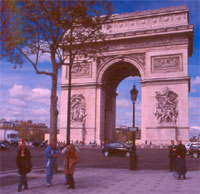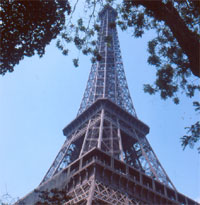|
For
me, time in Paris is a stroll arm-in-arm with someone
you love down the Champs-Elysées, a shared glass
of wine at a cozy outdoor café, a leisurely cruise
down the River Seine, or a lingering moment at a Van
Gogh in the Musée d'Orsay.
However
you choose to spend your time in Paris, the City of
Light will illuminate a place in your heart like no
other. Romance is as common here as a smile from a stranger.
Is there a more beautiful way to say "I Love You" than in the French language? Je t'aime is at once lyrical and sensual. French is,
without question, the language of love. Surely Parisians
must think of their city in the same terms as visitors,
n'est-ce pas? (don't you think?) While they may not
acknowledge the Eiffel Tower, the Arc de Triomphe, the
Louvre or the Cathedral of Notre-Dame on a daily basis,
they are most certainly a source of national pride.
And there are few in the world that haven't heard of
these symbols, and many more have been fortunate enough
to have seen them in their lifetime.
 |
|
The
Arc de Triomphe, Paris |
Paris
should be on every traveler's wish list. This is a city
of energy and it invariably energizes those who come
here to feel its vitality. As you walk the streets,
there is something of value at every corner, every turn,
every neighborhood. Paris doesn't whisper about its
fame, it proclaims it loudly-and rightly so. Avail yourself
to all that the city has to offer. Upon arrival, open
your heart and your mind and let Paris seduce you. Along
the Avenue des Champs-Elysées, from the Arc de
Triomphe to the Place de la Concorde you will find a
world of beautiful people, cafés, theaters, museums
and fine restaurants-and the heart and soul of Paris.
At the "rond-point," where the boulevard ends,
resides a splendid garden with dancing fountains and
imposing statues. It's virtually impossible not to pause
every few steps along the famed boulevard to marvel
at all the sights, but press on, for just ahead is the
magnificent Louvre and its treasured art, adored by
throngs of visitors who jam the turnstiles and wait
for hours in line to see the haunting Mona Lisa, Venus
de Milo and the Seated Scribe. The Louvre, once the
palace of the monarchs, is a mere 10 minutes from the
Opera District, and if you cross the Pont du Carrousel
(bridge), you'll be at the Musée d'Orsay and
its incredible collection of works by Impressionists
Monet, Cézanne and others.
 |
The
Eiffel Tower, Paris |
Not
far from this converted railway station turned museum
is the Eiffel Tower, the symbol of Paris for more than
113 years. The tower is an ideal vantage point for viewing
the whole of the city below and the easily identifiable
landmarks such as Les Invalides, the Ecole Militaire
and the gardens of Trocadéro. While this perspective
is inspiring, it lacks the intimacy and romance of a
lunch or dinner cruise on the Bateaux Parisiens, which
ply the Seine from moorings a mere stone's throw from
the tower. These glass-topped cozy vessels glide ever
so smoothly on this main Paris artery past the various
sections of the city with commentary offered by insightful
guides in several languages. Paris from the river seems
to define the differences between the city's districts
more clearly and the contrast is quite striking.
Upriver
from the Eiffel Tower, you see the entire traditional
and historic districts: the Palais de Tokyo, Grand and
Petit Palais, Assemblée Nationale, Tuileries,
the Louvre...but then, everything changes beyond pont
Charles-de-Gaulle. The modern Paris comes into focus
with less familiar architecture: the Ministry of Finance,
Palais Omnisports de Paris-Bercy with its grassy slopes,
and the huge towers of the National Library. But you'll
also come to admire the bridges over the River Seine,
especially the Pont-Neuf, the oldest, most famous and
most popular...particularly with lovers. Easily recognizable
by the small half-moon shaped overhangs that allow couples
to linger over the Seine, the bridge has appeared in
countless paintings and has been the backdrop for many
films. It remains virtually unchanged since it was built
in the 17th century. In summer, from mid-July to the
end of August, the river's right bank is closed to all
but foot traffic, and the area between quai des Tuileries
and quai Henri IV-some three miles- is invaded by thousands
of pedestrians seated in deck chairs, under colorful
parasols or under palm trees, while still more take
part in a number of "beach" activities. Others
may wait for the evening to attend one of the many concerts
before going on to clubs, guinguettes (open-air cafés)
or to shows. All Paris bridges are now illuminated,
making an evening walk along the river a joyous endeavor.
Paris
nightlife is legendary, and still at the height of its
popularity is the famed Moulin Rouge cabaret, entertaining
locals and visitors since 1889. Many international performers
have appeared there, but the French Cancan and the paintings
by Henri de Toulouse-Lautrec were responsible for its
popularity. The show's concept is the same as over 100
years ago: feathers, rhinestones and sequins, fabulous
settings, original music and some of the most beautiful
women in the world. The Moulin Rouge is in the Pigalle
section of the city, an area synonymous with Parisian
nightlife.
Paris
is divided into 20 districts (arrondissements), and
within those districts there are further distinctions
to define the locale. For example, the Moulin Rouge
is in "Village Paris," a place of small neighborhoods
reminiscent of provincial French villages. Montmartre
is here, and it is certainly one of the most diverse
quarters in the city. Crowds of visitors around Sacré-Coeur
mingle with locals on café terraces in Place
des Abbesses, while shoppers on the boulevard visit
the bazaars and specialty stores.
Other
enclaves include, among others, Hip Paris, Timeless
Paris, Mythical Paris and Undiscovered Paris. The latter,
in the 12th arrondissement, has really come into its
own as the place to see and be seen. In this eastern
sector is Bercy Village, a paved courtyard lined with
former wine warehouses that have been converted into
quaint structures housing restaurants with flowered
terraces, boutiques, art galleries, markets and cinemas.
In the evening, this wood and stone complex draws Parisians
in droves because of its homey atmosphere. There is
only foot traffic in Bercy Village and strolling the
brick street offers tourists an opportunity to immerse
themselves in French culture.
The
village is a perfect place for an initial introduction
to Paris and one can stay at the trendy Sofitel Paris
Bercy just minutes from the village center. Nearby is
the metro terminal at Cour St-Emilion, where you can
board the train and be whisked to every other part of
the city in a matter of minutes. Bercy can be the door
to your Paris experience. Open it enthusiastically.
The
City of Versailles
A Crowning Achievement
It's
good to be king. If just for a day.
That line from a Tom Petty song is most apropos after
you see the splendor of the Palace at Versailles and
its magnificent gardens. Though Louis XIII had a hunting
lodge and garden built there, it was Louis XIV who was
the driving force behind the creation of a sumptuous
estate and caused it to become the symbol of absolute
monarchy. From 1682-1789, everything at Versailles was
crafted especially for the service of the king.
Not
too close to Paris, but not too far away, the estate
was built at great expense-all for the magnificence
of the king. The town, the annexes, including the stables,
the Grand Commun for the lodgings of the officers of
the royal house, the wings for the ministers, the château
with its public and private apartments, the gardens,
the park, the hunting grounds-everything was oriented
around a main axis passing through the very center of
the royal dwelling, where the king's bedchamber was
located. He commanded that no house in the city could
be built to a height that he couldn't see over their
roofs from his bed.
Today,
Versailles is still a beautiful area and the château
holdings are vast, despite losing its hunting
grounds. Its interior is breathtaking, with 700 rooms,
2,153 windows and 67 staircases. Most notable are the
Hall of Mirrors, the War Drawing Room and the Peace
Drawing Room, and the king and queen's bedchambers. The Hall of Mirrors functions as a passageway to the
king's apartment. The monarch gave audience there, received
dignitaries and held grand celebrations. The
Peace Drawing Room, as its name suggests, is dedicated
to peace and its decorations reflect that, as does the
décor in the War Drawing Room.
Outside
in the gardens, the openness and scope characterize
the work of Le Nôtre, the landscape architect.
He gives great importance to the central point - the
terrace of the château-around which all of the
other parts of the gardens have been arranged. From
the terrace, Le Nôtre draws your eye to the horizon
while guiding your view through the landscape patterns,
pathways, canals and fountains which you cannot avoid
taking in. It's a masterful approach and breathtaking.
You can walk the gardens, but a leisurely ride in a
horse-drawn carriage with commentary is far more engaging.
Do
not miss an opportunity to also stroll through the town,
where you will find cobbled streets and historic alleyways,
antique shops, food and flower markets, and cozy cafés
such as Le Boeuf à la Mode, an authentic bistro
of the 1930s, where you can dine upstairs overlooking
the Marshal Foch square.
If
you stay overnight in Versailles, get the feel of royalty
by staying at the storied Trianon Palace Hotel situated
on seven acres at the edge of the Royal Domain of Louis
XIV and opened in 1910. The architect, René Sergent,
used the same cut stone as the palace and constructed
the hotel in the same classical style. There are two
buildings, one historic, called the Palace, and the
second, more modern, called the Pavillon. They are linked
by an underground passageway and its 99 rooms are decorated
in the Louis XV style of the Palace. Both buildings
have views overlooking the gardens of the hotel and
the city of Versailles.
Sofitel Paris Bercy is a four-star hotel just a seven-minute subway ride
from the Place de la Madeleine. The 376-room and suite hotel includes a convention centre, and an underground car park able to accommodate up to 16 coaches, a facility unique in Paris. Tel: 011/33/1/44-67-34-00 or visit www.sofitel.com to make reservations.
|